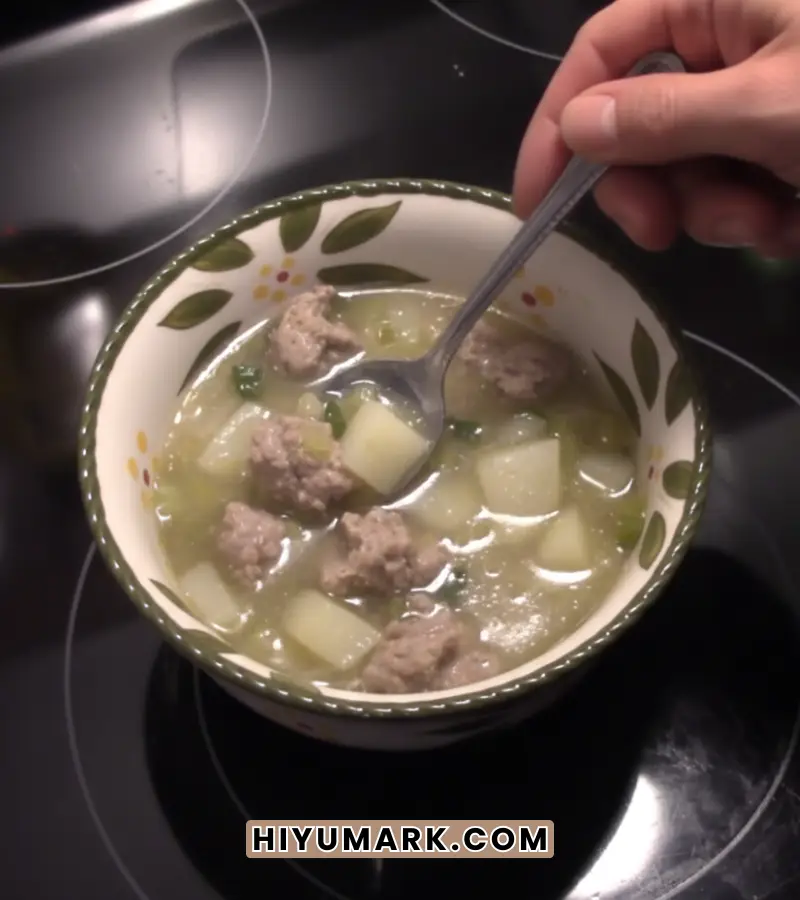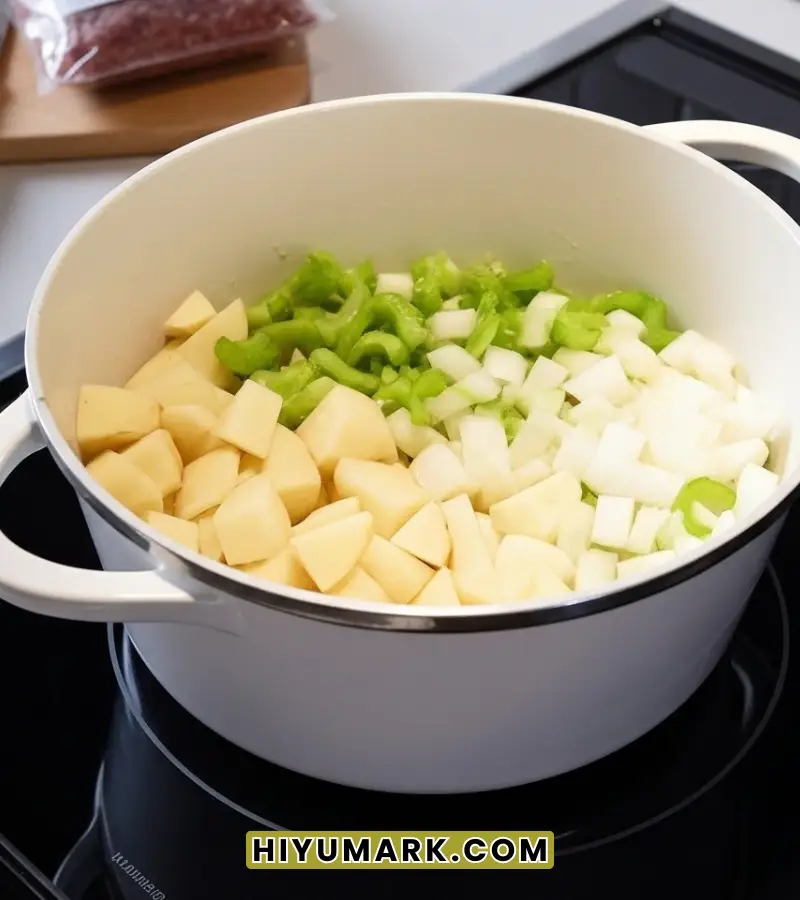I’ve cooked this dish for years, studying its roots and refining the steps so anyone can make it well.
In this guide, you’ll learn the true story behind the WPA Soup Recipe, the best ingredients to use, smart swaps, and a clear method that turns humble produce into deep, comforting flavor.
What Is WPA Soup and Why It Endures?
WPA Soup is a budget vegetable soup born during the Great Depression. It uses simple, low-cost foods to feed a crowd with warmth and dignity. The WPA Soup Recipe proves that good food can be honest, filling, and full of care.

At its core, this soup is about resourcefulness. With a few vegetables, a little starch, and time, you get a bowl that tastes like home. I lean on this recipe in tight weeks, or when I want comfort without the cost.
If this skillet supper hits the spot, try my Hoover Stew – same cozy flavor with pasta, tomato, and simple pantry staples.
Craving something heartier? My Poor Man’s Meal brings smoky skillet comfort, potatoes, onions, and beef – all on a tight budget.
For breakfast the next day, serve Creamed Chipped Beef on Toast – rich, salty, and perfect with leftover meatloaf slices.
Round out the meal with Depression-Era Meatloaf – another family-approved classic made from humble ingredients and timeless technique.
A Brief History of WPA Soup
During the 1930s, public kitchens and community programs worked to feed families. The Works Progress Administration helped fund jobs and local support. Simple soups, built from donated produce and staples, were common. The WPA Soup Recipe reflects that era.
Records from community kitchens show how cooks stretched cabbage, potatoes, onions, and carrots. They added water, bones if they had them, and cooked low and slow. The result was cheap, safe, and nourishing. Today, the WPA Soup Recipe carries that spirit of care and thrift.
Core Ingredients for an Authentic WPA Soup Recipe
You can make the WPA Soup Recipe with a short list. Aim for a good mix of sweet, savory, and starchy notes.
Base vegetables
- Onion gives depth and aroma.
- Carrot adds sweetness and color.
- Celery brings a clean, herbal note.
Hearty fillers
- Potato makes it satisfying and thick.
- Cabbage adds bulk and stays tender-crisp.
Liquid and fat
- Water or light broth keeps it clean and cheap.
- A spoon of oil or a knob of fat helps flavor bloom.
Pantry helpers
- Garlic, bay leaf, and black pepper for balance.
- Salt to taste. A splash of vinegar brightens at the end.
Smart swaps
- Turnip or parsnip for carrot.
- Rice, barley, or small pasta for potato.
- Frozen mixed vegetables if fresh is scarce.
I prefer green cabbage and waxy potatoes, since they hold shape. For the WPA Soup Recipe, keep the list short and the cuts even. Small, even cubes cook steady and taste better.
Step-by-Step WPA Soup Recipe
This method builds flavor in layers and avoids mushy vegetables. You can double it for a crowd.

Ingredients for 6 servings
- 2 tablespoons oil or butter
- 1 large onion, diced
- 2 carrots, diced
- 2 celery stalks, diced
- 2 garlic cloves, minced
- 4 cups chopped green cabbage
- 2 medium potatoes, diced small
- 6 cups water or light broth
- 1 bay leaf
- 1 teaspoon salt, plus more to taste
- 1 teaspoon black pepper
- 1 tablespoon apple cider vinegar or lemon juice
- Optional: 1 cup cooked beans or 1 cup chopped tomatoes
Steps
- Warm the pot. Set a large pot over medium heat and add the fat.
- Build the base. Add onion, carrot, and celery. Cook 5 to 7 minutes, until soft and sweet.
- Add garlic and cabbage. Stir 1 minute until fragrant.
- Add potatoes and liquid. Pour in water or broth. Add bay leaf, salt, and pepper.
- Simmer gently. Bring to a low simmer. Cook 20 to 25 minutes until potatoes are tender.
- Adjust flavor. Stir in vinegar. Taste and add more salt and pepper as needed.
- Optional add-ins. Fold in beans or tomatoes and warm 3 minutes.
- Rest. Let the WPA Soup Recipe sit 5 minutes before serving for better flavor.
Chef’s note: Low simmer keeps the broth clear and the vegetables whole. A fast boil can break them down and mute the taste.
Flavor Boosters and Variations
The WPA Soup Recipe is flexible. Use what you have and build taste in smart ways.
Easy boosters
- A spoon of tomato paste adds body.
- A pinch of paprika or dried thyme adds warmth.
- A Parmesan rind or a splash of soy sauce deepens umami.
Protein ideas
- White beans or lentils make it extra hearty.
- Shredded chicken or a ham bone if you have leftovers.
Seasonal swaps
- Summer: zucchini, green beans, corn.
- Winter: turnips, parsnips, kale.
Texture Tricks
- Mash a few potatoes in the pot to thicken.
- Add a handful of small pasta in the last 8 minutes.
I often add a bay leaf and a spoon of vinegar at the end. It brightens the WPA Soup Recipe without extra salt.
Nutrition, Allergen Notes, and Dietary Swaps
This soup is light, fiber-rich, and low in fat. A typical bowl has mostly vegetables, some starch, and simple seasoning. It keeps sodium in check if you start with water and salt to taste.

Dietary swaps
- Vegan: use oil and water or vegetable broth.
- Gluten-free: skip pasta or use a gluten-free pasta.
- Low sodium: use water, no-salt seasoning, and finish with acid for pop.
A tip from my kitchen: when I cook the WPA Soup Recipe for kids or older folks, I dice small and cook until just tender. Small cuts are easier to chew and digest.
Budget and Meal Prep Tips
The WPA Soup Recipe is built for savings. Buy in-season and use the full vegetable when you can.
Money savers
- Choose whole cabbage and big carrots. They cost less per pound.
- Save clean peelings of carrot and onion in the freezer for broth.
- Double the batch and freeze in flat bags for quick meals.
Meal prep
- Chop vegetables the night before and store in a sealed container.
- Cook grains or beans ahead and add when reheating.
Leftover love
- Stir in leftover rice or roasted vegetables on day two.
- Turn cold soup into a pot pie filling with a simple crust.
Serving Ideas, Storage, and Reheating
Serve the WPA Soup Recipe with crusty bread or a simple salad. A drizzle of olive oil and black pepper on top adds a nice finish. Fresh parsley makes it bright.
Storage and reheating
- Store in the fridge for 4 days.
- Freeze up to 3 months.
- Reheat gently over low heat. Add a splash of water if it has thickened.
Safety tip: Chill fast by dividing into shallow containers. This keeps the taste clean and the texture firm.
Common Mistakes and How to Fix Them
The WPA Soup Recipe is forgiving, but a few errors can dull flavor. Here is how to avoid them.
Common issues
- Bland taste: add salt in stages and finish with acid.
- Mushy vegetables: keep a gentle simmer and cut pieces even.
- Oily top: use only enough fat to sweat the base vegetables.
Quick fixes
- Add a small spoon of tomato paste for depth.
- Add a splash of vinegar or lemon for brightness.
- Stir in chopped herbs at the end for fresh flavor.
When I rushed the soup once, I boiled it hard and lost the sweet notes. Now I simmer low and let time do the work. The WPA Soup Recipe rewards patience.
Frequently Asked Questions
What does WPA stand for in WPA Soup Recipe?
It stands for Works Progress Administration, a New Deal program from the 1930s. The name points to community cooking that fed people during hard times.
Can I make the WPA Soup Recipe in a slow cooker?
Yes. Sweat the base vegetables in a pan first, then add everything to the slow cooker on low for 6 to 7 hours. Finish with vinegar and adjust salt.
How do I thicken the WPA Soup Recipe without cream?
Mash some potatoes in the pot or stir in a spoon of tomato paste. You can also add a small handful of rice or barley.
Is the WPA Soup Recipe good for freezing?
It freezes well. Cool fast, pack in portions, and reheat gently to keep the vegetables tender.
What can I use if I do not have cabbage for the WPA Soup Recipe?
Use kale, collards, or even shredded Brussels sprouts. The taste will shift a bit, but it stays hearty and bright.
How can I add protein to the WPA Soup Recipe without meat?
Add beans, lentils, or split peas. They hold up well and soak in the broth flavor.
Conclusion
The WPA Soup Recipe is a lesson in care, thrift, and flavor. With a few vegetables and calm hands, you can make a pot that feeds hearts as much as it feeds bellies. Keep it simple, taste as you go, and let time bring the pieces together.
Ready to cook? Gather your staples, try the recipe tonight, and share your twist in the comments. If this helped, subscribe for more practical, budget-friendly comfort recipes.
WPA Soup Recipe
Course: SoupsCuisine: AmericanDifficulty: Easy6
servings20
minutes25
minutes220
kcal45
minutesA hearty vegetable soup made with cabbage, potatoes, carrots, and simple pantry staples. This WPA Soup Recipe is comforting, affordable, and rooted in Depression-era tradition.
Ingredients
2 tbsp oil or butter
1 large onion, diced
2 carrots, diced
2 celery stalks, diced
2 garlic cloves, minced
4 cups cabbage, chopped
2 medium potatoes, diced small
6 cups water or light broth
1 bay leaf
1 tsp salt (adjust to taste)
1 tsp black pepper
1 tbsp apple cider vinegar or lemon juice
Optional: 1 cup cooked beans or chopped tomatoes
Directions
- Heat oil in a large pot over medium heat.
- Add onion, carrot, and celery; cook 5–7 minutes until soft.
- Stir in garlic and cabbage; cook 1 minute.
- Add potatoes, broth or water, bay leaf, salt, and pepper.
- Simmer gently for 20–25 minutes until vegetables are tender.
- Stir in vinegar; adjust salt and pepper.
- Optional: add beans or tomatoes and cook 3 more minutes.
- Let rest 5 minutes before serving.
Recipe Video
Notes
- Keep the soup at a gentle simmer so vegetables stay whole and the broth remains clear. Add vinegar at the end - it brightens the flavor without adding more salt.
